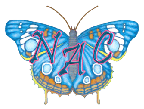Volume 6 Issue 9

CROCHET


CROCHET

There is not much known about the origin of crochet or how long it has been in existence. There are several theories, but the three main theories are:
1. It originated in Arabia, spread to Tibet and onward to Spain. From there it followed the Arab trade routes to other Mediterranean countries.
2. A primitive tribe in South America was said to have used crochet adornments in rites of puberty.
3. Early examples from China were found of three-dimensional dolls worked in crochet.
Not only do we call it "crochet" but the French do, as well as the Belgians, Italians, and Spanish-speaking people. In Holland it is called "haken", in Denmark "haekling", in Norway
"hekling", and in Sweden "virkning".
The word "crochet" come from "croc", or "croche", which is the Middle French word for hook, and the Old Norse word for hook is "krokr".
Crochet as we know it today is believed to have been developed during the 16th century. In France it is known as "crochet lace" and in England as "chain lace". Walter Edmund Roth
visited descendants of the Guiana Indians in 1916 and found examples of true crochet. There is no known evidence found before 1800 in Europe. However, many sources believe that
crochet has been known since the 1500's in Italy under the name of "nun's work" or "nun's lace". It was made by nuns for the church textiles. Research has found examples of lace-making
and a lace tape, which has been preserved, but it is thought that crochet was not known in Italy in the 16th century under any name.
Research has also found that crochet may have a direct development from a very ancient Chinese needlework or embroidery practiced in Turkey, India, Persia and North Africa. It
reached Europe in the 1700s and was referred to as "tambouring," from the French word "tambour" or drum. In "tambouring", background fabric is stretched taut on a frame like
you would when embroidering. The thread is held underneath the fabric and a needle with a hook is inserted downward and a loop of the thread is brought up through the fabric. With
the loop still on the hook, the hook is then inserted a little farther along and another loop of the thread is brought up and worked through the first loop to form a chain stitch.
These hooks or needles were called "tambour hooks" and were as thin as sewing needles. Obviously, a very fine thread must have been used.
By the end of the 18th century, tambour became what the French called "crochet in the air". The background fabric was discarded and the stitch worked on its own.
Crochet began turning up in Europe in the early 1800s. It was not until the 1840's that there were published instructions for crochet designs. Mlle. Riego de la Branchardiere, was best
known for taking old-style needle and bobbin lace designs and turning them into crochet patterns that could easily be duplicated. She published many pattern books in
order for women to copy her designs. Mlle. Riego also claimed to have invented "lace-like" crochet, today called Irish crochet.
In Ireland, crochet began as a cottage industry. It was called "Irish crochet" or "guipure lace". In the mid 1800's, due to the great potato famine, it became a large industry to sup-
plement the income of the people. Some have suggested that four Irish nuns who were trained in a French convent introduced crochet to Ireland. It was common during that time for
each person to become skilled in making one thing and one thing only, such as a leaf or a flower. Another person would then crochet the different motifs together using a background
stitch.
In some countries, such as India, Greece, Italy, and Asian countries, it is still a cottage industry.
.
Another type of lace called "cheyne lace", from the 18th century, was made with a hook. A primitive form of crochet called "pjonting" also has been found from about 1820.
To view some fine examples of vintage crochet:
Vintage Crochet
RESOURCES:
Crochet Guild of America
Crochet History-Victorian & Edwardian Crochet
Alita Designs
AllFreeCrochet
The Next Monthly Newsletter will feature Haviland China.
![]()
Questions? Email Us!
SIGN UP HERE!
Get on our FREE Newsletter
Mailing List!

![]()

ACCEPTED!
Credit Card Payment Processing
 |

